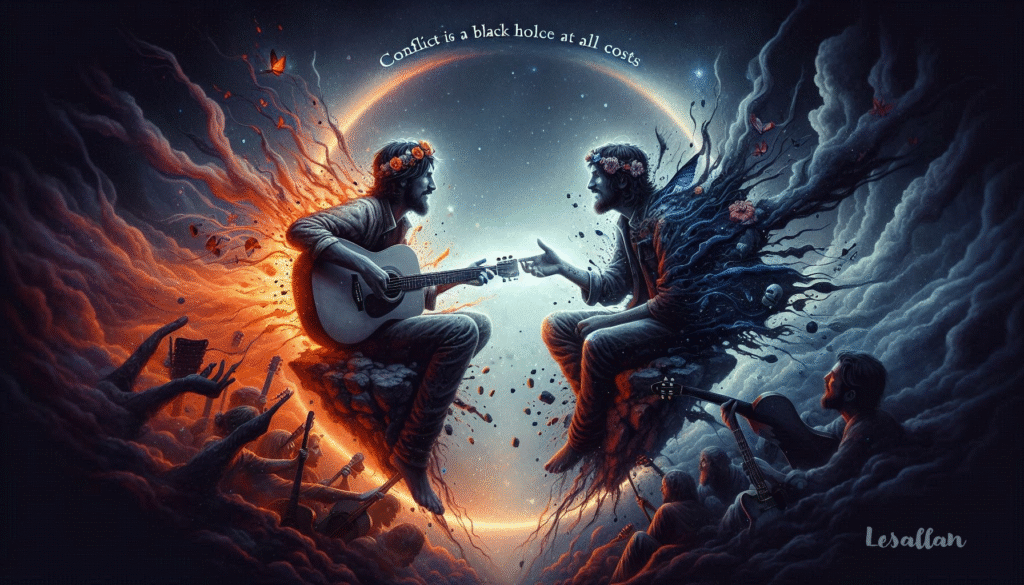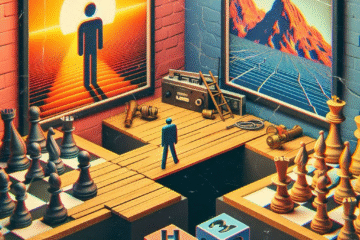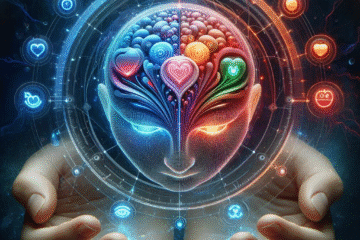Lesallan | May 25, 2025

Language Usage Response: Reflecting on Conflict in Musical Collaboration
Conflict, at its essence, often serves as a reflection of our internal beliefs and emotions. In my experience of collaborating musically with a friend on the guitar, the dynamics of our partnership occasionally spiraled into tension and misunderstanding. Considering the metaphor “conflict is a black hole to avoid at all costs” (Hocker, Berry, & Wilmot, 2022), I began to perceive our discord as a force that depleted our energy and created a void where creativity once thrived. Through this perspective, the conflict appeared both inevitable and destructive, drawing us away from the harmonious flow of our music.
Considering this negative metaphor, several resolution strategies emerge that could effectively counteract the dark pull of this “black hole.” First, establishing clear, honest communication can help shed light on hidden feelings and unmet expectations. By sharing individual perspectives on our needs during sessions, we can diffuse the sense of inevitable loss and avert a downward spiral. Second, intentionally scheduling time to discuss conflicts outside of our guitar playing may transform destructive energy into constructive dialogue. This separation allows us to debrief and pinpoint moments when tensions begin to escalate. Third, seeking the guidance of a neutral third party, such as a fellow musician or mentor, can offer an objective perspective and suggest innovative ways to restructure our collaborative process. By directly addressing and reframing the negative energy, we can prevent the conflict from becoming an all-consuming void.
In contrast, when I reframe the conflict using a positive metaphor, “conflict is akin to the syncopation in a musical masterpiece that adds unexpected depth,” a transformative new perspective emerges. This metaphor allows us to view the tension between differing musical ideas as an essential aspect of the creative process, rather than an insurmountable barrier to be avoided. With this hopeful frame in mind, three new options arise. First, I can explore improvisation techniques that embrace the underlying tension, transforming dissonance into innovative harmonies. Second, this friction can signal growth; by perceiving disagreement as an opportunity to refine my technical skills or to delve into fresh musical ideas, conflict becomes a catalyst for both personal and collaborative development. Finally, this reimagined understanding of conflict paves the way for structured creative brainstorming sessions, where we intentionally challenge one another’s ideas in a supportive environment, turning our differences into a symphony of diverse interpretations.
Reframing conflict through a lens of hope rather than helplessness is critically important, as this perspective significantly impacts our emotional responses and subsequent actions. Historically, conflict has often been perceived as an entirely negative phenomenon, synonymous with destruction and discord. However, contemporary scholarship suggests that when we recontextualize conflict as a dynamic element of human creativity, we harness its potential to catalyze growth and innovation.
Viewing conflict this way empowers individuals and groups to engage in constructive dialogue, seek mutually beneficial solutions, and deepen their relationships. This mindset transformation facilitates a shift from adversarial confrontation to collaborative exploration, where opposing viewpoints are regarded not as threats but as valuable contributions to a richer, more comprehensive understanding of a situation. Such reframing encourages a spirit of inquiry and openness, fostering an environment conducive to creative problem-solving.
Moreover, by embracing a hopeful outlook, we cultivate a sense of possibility that permeates our interpersonal interactions. This optimistic approach mitigates the fear and anxiety often associated with conflict and enhances resilience, enabling individuals to navigate challenges with an initiative-taking mindset. In doing so, potential discord can be redirected towards opportunities for connection and understanding, paving the way for personal and collective development.
Redefining our relationship with conflict as a source of creativity and connection rather than mere disruption holds the key to more robust and resilient relationships. This transformative perspective enriches our interactions and contributes to a broader social fabric that values innovation, empathy, and collaboration as essential components of human experience. By recognizing the inherent potential within conflicts, we position ourselves to leverage these moments as catalysts for growth, ensuring that the outcomes of such encounters lead to enhanced relational dynamics and creative evolution.
References:
Hocker, J. L., Berry, K., & Wilmot, W. (2022). Interpersonal conflict (11th ed.). McGraw Hill
Llc.


